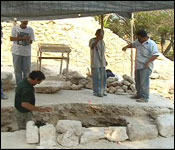 Two months ago, we told you about the work to restore the Santa Rita Mayan temple in Corozal to its former glory. The project, funded by NICH and the US Embassy simply hoped to remove some of the rubble that was obscuring the grandeur of the site. But in what started out as a restoration effort, the team from the Institute of Archeology has come upon some major finds, like that pelican figure we showed you last time.
Two months ago, we told you about the work to restore the Santa Rita Mayan temple in Corozal to its former glory. The project, funded by NICH and the US Embassy simply hoped to remove some of the rubble that was obscuring the grandeur of the site. But in what started out as a restoration effort, the team from the Institute of Archeology has come upon some major finds, like that pelican figure we showed you last time.
Well that's minor compared to what we were called out to see yesterday. 7news was there as Dr. Jaime Awe opened a Mayan burial crypt for the first time in over a thousand years! It's an epic moment and we caught it all on camera. Jules Vasquez has the story:…
Jules Vasquez reporting
All this week, conservatory work at Santa Rita slowed as under this tent site workers made what's being called "an incredible discovery." Under what's known as a stair block, the site manager saw tell-tale signs.
Dr. Jaime Awe - Director Of The Institute Of Archaeology
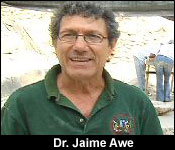 "A few days ago, Jorge came and said, 'You know, we have the stair block, which is located right in the middle of the stairway at the center line of the temple.' Well when we started to discuss this, and we agreed that we needed to put an excavation there because these stair-blocks, everywhere we find them on temples, We often find tombs associated with them. We decided we have to excavate there. They started to go down and they found these capstones."
"A few days ago, Jorge came and said, 'You know, we have the stair block, which is located right in the middle of the stairway at the center line of the temple.' Well when we started to discuss this, and we agreed that we needed to put an excavation there because these stair-blocks, everywhere we find them on temples, We often find tombs associated with them. We decided we have to excavate there. They started to go down and they found these capstones."
They left the three capstones and waited for the Director of the Institute of Archaeology Dr. Jaime Awe to come and open up a vault that no one had seen for over a thousand years. 7news was there yesterday as Awe lowered himself into the crypt to see for the first time what lies beneath. With some heavy lifting they removed the three capstones – weighty limestone slabs - to reveal a narrow opening – hardly wide enough for any modern person to wriggle into. But Awe just about fit into the crypt barely two feet high.
Dr. Jaime Awe
"Not a lot of space in this small tomb"
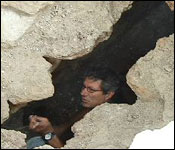
A small tomb indeed but fit for a big reveal as Awe led us on something like a live dig narrating his discovery in real time – all from a crouching position:
Dr. Jaime Awe
"Man, this is very interesting stuff down here. I can make out two individuals. We have one that looks male because of the size, extended, the head to the north, the feet to the south. We also have a second individual which is really interesting because the second individual is at the north end of the tomb. What I can say is that the person at the top, at that end, has two pots on top of the chest. Now, the individual that's lying fully extended, looks pretty tall. In fact if I can get a tape measure from somebody, I can get a sense of length of the skull. About 5 feet 6 inches, so probably male, just based on that height. Now, there are some really interesting artifacts associated with this individual lying down. I can see right by the side of the head there are two figurines. This one looks like it's made from resin poured in a mold, and if that's true that would make that a very unique artifact. I don't think we've ever found a figurine that's made from resin and poured into a mold. So that's awesome!
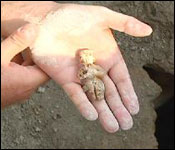
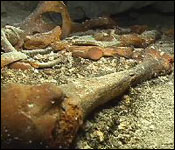 We lowered our camera in going down a few feet and a maybe a dozen centuries for a fascinating first-hand view at what has not been seen in a thousand years.
We lowered our camera in going down a few feet and a maybe a dozen centuries for a fascinating first-hand view at what has not been seen in a thousand years.
Dr. Jaime Awe
"Nobody has seen this since perhaps between 5 and 600 A.D. So far, it's more than a thousand years ago since anybody has been looking at this burial, and we get this opportunity for the first time today. So we're looking at the two figurines, that just passed by the camera. As you go further north, you can see the other younger individual, fetal position with two of the pots that are placed right over the chest area. You can also see some bits and pieces of the painted stucco. We think those pots date to the early Classic Period somewhere between 350 - 600A.D. You can see all the teeth, it's only the right side of the face that's smashed. It looks like a younger person than the fully extended one. So we don't know if that was a victim sacrificed to accompany the other person or a member of the family, perhaps the wife."
That's believed to be a child or female with a smashed skull. The other figure is believed to be a male:
Dr. Jaime Awe
"So we're going over the chest area right now.As you can see, there are hundreds of small bones. Now, you're coming over the mandible; that's the lower jaw. You can still see how the teeth within the mandible are really nicely preserved. Higher up from the mandible is the skull, but that skull has been crushed; it's not complete. Just above there you can see a big shell object. You can see one of the figurines on the screen right now. One of them is made from manatee bone or some other kind of bone. Just above that, there is a small little circle, ceramic, and then another figurine made out of resin, or you know, some kind of material that had to be melted and poured into a mold. But right in that little area there, there are all kinds of artifacts that we won't know exactly what we have there until we start take them out. But there a lot of little pieces that may be part of a mosaic."
And for their thousands of years, these bones hold so much data and the discovery opens up so many new questions. Long study will have to be made of everything in here.
Dr. Jaime Awe
"The discovery of this tomb is a really amazing discovery. It is a wonderful opportunity for us to learn more about the ancient Maya that lived at Santa Rita."
And it is also a lucky dig because usually burials are not so easily revealed.
Dr. Jaime Awe
"What was really good about this tomb is that often the Maya fill in the tomb with dirt. This one, they didn't do that, so as soon we lifted the capstones, we could see just about everything they had placed in there. We could see the two skeletons, the one that's extended, head to the north. We also saw the other skeleton that's to the north end of the chamber in fetal position. It also allowed us to see some of the artifacts, that one figurine that's made up of probably resin. It's a first for the country of Belize. I can't remember anything like that being found anywhere in the central Maya area."
And now it will form a part of the legend of Santa Rita
Dr. Jaime Awe
"People will be able to talk about these things to the visitors, both Belizean vistors and foreign visitors that come to see the capital of the Ancienty city of Chetumal."
A city that still has secrets to reveal.
According to published data, four other burial sites were previously found at Santa Rita – and these also date to the pre-classic period, which is 1200 to 900 BC.
| 
